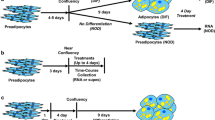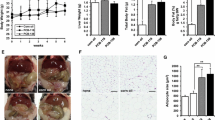Abstract
Subcutaneous white adipose tissue is capable of becoming thermogenic in a process that is referred to as “beiging.” Beiging is associated with activation of the uncoupling protein, UCP1, and is known to be important for preventing adipose hypertrophy and development of insulin resistance. Polychlorinated biphenyls (PCBs) accumulate in fat, and it is hypothesized that disruption of adipogenesis and adipocyte function by PCBs may be causative in the development of obesity and diabetes. We developed immortal human subcutaneous preadipocytes that, when differentiated, are capable of beiging. Preadipocytes that were treated with polychlorinated biphenyl congener 126 (PCB126), followed by differentiation, were suppressed for their ability to activate UCP1 upon β-adrenergic stimulation with norepinephrine (NE), demonstrating a block in the beiging response. Treatment of preadipocytes with another known endogenous AhR agonist, indoxyl sulfate (IS), followed by differentiation also blocked the NE-stimulated upregulation of UCP1. Knockdown of the aryl hydrocarbon receptor (AhR) caused the preadipocytes to be refractory to PCB126 and IS effects. The chemical AhR antagonist, CH223191, was effective at preventing the effects of PCB126 but not IS, indicating AhR ligand specificity of CH223191. Repression of NE-induced UCP1 upregulation was also observed when already-differentiated mature adipocytes were treated with PCB126 but not IS. These results indicate that exposure of preadipocytes to endogenous (IS) or exogenous (PCB126) AhR agonists is effective at blocking them from becoming functional adipocytes that are capable of the beiging response. Mature adipocytes may have differential responses. This finding suggests a mechanism by which dioxin-like PCBs such as PCB126 could lead to disruption in energy homeostasis, potentially leading to obesity and diabetes.





Similar content being viewed by others
Abbreviations
- PCB126:
-
polychlorinated biphenyl congener 126
- UCP1:
-
uncoupling protein 1
- NPAD:
-
normal preadipocytes
- shRNA:
-
short hairpin RNA
- AhR:
-
aryl hydrocarbon receptor
- IS:
-
indoxyl sulfate
References
Alexander DL, Ganem LG, Fernandez-Salguero P, Gonzalez F, Jefcoate CR (1998) Aryl-hydrocarbon receptor is an inhibitory regulator of lipid synthesis and of commitment to adipogenesis. J Cell Sci 111:3311–3322
Arsenescu V, Arsenescu RI, King V, Swanson H, Cassis LA (2008) Polychlorinated biphenyl-77 induces adipocyte differentiation and proinflammatory adipokines and promotes obesity and atherosclerosis. Environ Health Perspect 116:761–768
Baker NA, Karounos M, English V, Fang J, Wei Y, Stromberg A, Sunkara M, Morris AJ, Swanson HI, Cassis LA (2013) Coplanar polychlorinated biphenyls impair glucose homeostasis in lean C57BL/6 mice and mitigate beneficial effects of weight loss on glucose homeostasis in obese mice. Environ Health Perspect 121:105–110
Baker NA, Shoemaker R, English V, Larian N, Sunkara M, Morris AJ, Walker M, Yiannikouris F, Cassis LA (2015) Effects of adipocyte aryl hydrocarbon receptor deficiency on PCB-induced disruption of glucose homeostasis in lean and obese mice. Environ Health Perspect 123:944–950
Barouki R, Aggerbeck M, Aggerbeck L, Coumoul X (2012) The aryl hydrocarbon receptor system. Drug Metabol Drug Interact 27:3–8
Bessede A, Gargaro M, Pallotta MT, Matino D, Servillo G, Brunacci C, Bicciato S, Mazza EM, Macchiarulo A, Vacca C, Iannitti R, Tissi L, Volpi C, Belladonna ML, Orabona C, Bianchi R, Lanz TV, Platten M, Della Fazia MA, Piobbico D, Zelante T, Funakoshi H, Nakamura T, Gilot D, Denison MS, Guillemin GJ, DuHadaway JB, Prendergast GC, Metz R, Geffard M, Boon L, Pirro M, Iorio A, Veyret B, Romani L, Grohmann U, Fallarino F, Puccetti P (2014) Aryl hydrocarbon receptor control of a disease tolerance defence pathway. Nature 511:184–190
Biljes D, Hammerschmidt-Kamper C, Kadow S, Diel P, Weigt C, Burkart V, Esser C (2015) Impaired glucose and lipid metabolism in ageing aryl hydrocarbon receptor deficient mice. EXCLI J 14:1153–1163
Brodie AE, Azarenko VA, Hu CY (1996) 2,3,7,8-Tetrachlorodibenzo-p-dioxin (TCDD) inhibition of fat cell differentiation. Toxicol Lett 84:55–59
Brulport A, Le Corre L, Chagnon MC (2017) Chronic exposure of 2,3,7,8-tetrachlorodibenzo-p-dioxin (TCDD) induces an obesogenic effect in C57BL/6 J mice fed a high fat diet. Toxicology 390:43–52
Cohen P, Spiegelman BM (2015) Brown and beige fat: molecular parts of a thermogenic machine. Diabetes 64:2346–2351
Cohen P, Spiegelman BM (2016) Cell biology of fat storage. Mol Biol Cell 27:2523–2527
Esser C, Rannug A (2015) The aryl hydrocarbon receptor in barrier organ physiology, immunology, and toxicology. Pharmacol Rev 67:259–279
Gadupudi G, Gourronc FA, Ludewig G, Robertson LW, Klingelhutz AJ (2015) PCB126 inhibits adipogenesis of human preadipocytes. Toxicol in Vitro 29:132–141
Gourronc FA, Robertson LW, Klingelhutz AJ (2018) A delayed proinflammatory response of human preadipocytes to PCB126 is dependent on the aryl hydrocarbon receptor. Environ Sci Pollut Res Int 25:16481-16492
Hsu HF, Tsou TC, Chao HR, Kuo YT, Tsai FY, Yeh SC (2010) Effects of 2,3,7,8-tetrachlorodibenzo-p-dioxin on adipogenic differentiation and insulin-induced glucose uptake in 3 T3-L1 cells. J Hazard Mater 182:649–655
Hubbard TD, Murray IA, Perdew GH (2015) Indole and tryptophan metabolism: endogenous and dietary routes to ah receptor activation. Drug Metab Dispos 43:1522–1535
Jin UH, Lee SO, Sridharan G, Lee K, Davidson LA, Jayaraman A, Chapkin RS, Alaniz R, Safe S (2014) Microbiome-derived tryptophan metabolites and their aryl hydrocarbon receptor-dependent agonist and antagonist activities. Mol Pharmacol 85:777–788
Kajimura S, Spiegelman BM, Seale P (2015) Brown and beige fat: physiological roles beyond heat generation. Cell Metab 22:546–559
Kerley-Hamilton JS, Trask HW, Ridley CJ, Dufour E, Ringelberg CS, Nurinova N, Wong D, Moodie KL, Shipman SL, Moore JH, Korc M, Shworak NW, Tomlinson CR (2012) Obesity is mediated by differential aryl hydrocarbon receptor signaling in mice fed a Western diet. Environ Health Perspect 120:1252–1259
Kim SH, Henry EC, Kim DK, Kim YH, Shin KJ, Han MS, Lee TG, Kang JK, Gasiewicz TA, Ryu SH, Suh PG (2006) Novel compound 2-methyl-2H-pyrazole-3-carboxylic acid (2-methyl-4-o-tolylazo-phenyl)-amide (CH-223191) prevents 2,3,7,8-TCDD-induced toxicity by antagonizing the aryl hydrocarbon receptor. Mol Pharmacol 69:1871–1878
Lee P, Werner CD, Kebebew E, Celi FS (2014) Functional thermogenic beige adipogenesis is inducible in human neck fat. Int J Obes 38:170–176
Lin CJ, Liu HL, Pan CF, Chuang CK, Jayakumar T, Wang TJ, Chen HH, Wu CJ (2012) Indoxyl sulfate predicts cardiovascular disease and renal function deterioration in advanced chronic kidney disease. Arch Med Res 43:451–456
Littlejohn NK, Keen HL, Weidemann BJ, Claflin KE, Tobin KV, Markan KR, Park S, Naber MC, Gourronc FA, Pearson NA, Liu X, Morgan DA, Klingelhutz AJ, Potthoff MJ, Rahmouni K, Sigmund CD, Grobe JL (2016) Suppression of resting metabolism by the angiotensin AT2 receptor. Cell Rep 16:1548–1560
Livak KJ, Schmittgen TD (2001) Analysis of relative gene expression data using real-time quantitative PCR and the 2(-Delta Delta C(T)) Method. Methods 25:402–408
Mulero-Navarro S, Fernandez-Salguero PM (2016) New trends in aryl hydrocarbon receptor biology. Front Cell Dev Biol 4:45
Olsen H, Enan E, Matsumura F (1998) 2,3,7,8-Tetrachlorodibenzo-p-dioxin mechanism of action to reduce lipoprotein lipase activity in the 3 T3-L1 preadipocyte cell line. J Biochem Mol Toxicol 12:29–39
Patel P, Abate N (2013a) Body fat distribution and insulin resistance. Nutrients 5:2019–2027
Patel P, Abate N (2013b) Role of subcutaneous adipose tissue in the pathogenesis of insulin resistance. J Obes 2013:489187
Perkins A, Phillips JL, Kerkvliet NI, Tanguay RL, Perdew GH, Kolluri SK, Bisson WH (2014) A structural switch between agonist and antagonist bound conformations for a ligand-optimized model of the human aryl hydrocarbon receptor ligand binding domain. Biology (Basel) 3:645–669
Phillips M, Enan E, Liu PC, Matsumura F (1995) Inhibition of 3 T3-L1 adipose differentiation by 2,3,7,8-tetrachlorodibenzo-p-dioxin. J Cell Sci 108:395–402
Roh E, Kwak SH, Jung HS, Cho YM, Pak YK, Park KS, Kim SY, Lee HK (2015) Serum aryl hydrocarbon receptor ligand activity is associated with insulin resistance and resulting type 2 diabetes. Acta Diabetol 52:482–495
Rosen ED, Spiegelman BM (2014) What we talk about when we talk about fat. Cell 156:20–44
Ruzzin J, Petersen R, Meugnier E, Madsen L, Lock EJ, Lillefosse H, Ma T, Pesenti S, Sonne SB, Marstrand TT, Malde MK, Du ZY, Chavey C, Fajas L, Lundebye AK, Brand CL, Vidal H, Kristiansen K, Froyland L (2010) Persistent organic pollutant exposure leads to insulin resistance syndrome. Environ Health Perspect 118:465–471
Stejskalova L, Dvorak Z, Pavek P (2011) Endogenous and exogenous ligands of aryl hydrocarbon receptor: current state of art. Curr Drug Metab 12:198–212
Stockinger B, Di Meglio P, Gialitakis M, Duarte JH (2014) The aryl hydrocarbon receptor: multitasking in the immune system. Annu Rev Immunol 32:403–432
Tchkonia T, Morbeck DE, Von Zglinicki T, Van Deursen J, Lustgarten J, Scrable H, Khosla S, Jensen MD, Kirkland JL (2010) Fat tissue, aging, and cellular senescence. Aging Cell 9:667–684
Vu BG, Gourronc FA, Bernlohr DA, Schlievert PM, Klingelhutz AJ (2013) Staphylococcal superantigens stimulate immortalized human adipocytes to produce chemokines. PLoS One 8:e77988
Vu BG, Stach CS, Kulhankova K, Salgado-Pabon W, Klingelhutz AJ, Schlievert PM (2015) Chronic superantigen exposure induces systemic inflammation, elevated bloodstream endotoxin, and abnormal glucose tolerance in rabbits: possible role in diabetes. MBio 6:e02554
Wada T, Sunaga H, Miyata K, Shirasaki H, Uchiyama Y, Shimba S (2016) Aryl hydrocarbon receptor plays protective roles against high fat diet (HFD)-induced hepatic steatosis and the subsequent lipotoxicity via direct transcriptional regulation of socs3 gene expression. J Biol Chem 291:7004–7016
Wang C, Xu CX, Krager SL, Bottum KM, Liao DF, Tischkau SA (2011) Aryl hydrocarbon receptor deficiency enhances insulin sensitivity and reduces PPAR-alpha pathway activity in mice. Environ Health Perspect 119:1739–1744
Xu CX, Wang C, Zhang ZM, Jaeger CD, Krager SL, Bottum KM, Liu J, Liao DF, Tischkau SA (2015) Aryl hydrocarbon receptor deficiency protects mice from diet-induced adiposity and metabolic disorders through increased energy expenditure. Int J Obes 39:1300–1309
Zhao B, Degroot DE, Hayashi A, He G, Denison MS (2010) CH223191 is a ligand-selective antagonist of the Ah (dioxin) receptor. Toxicol Sci 117:393–403
Acknowledgments
We thank Dr. Hans Joachim-Lehmler of the Iowa Superfund Research Program (P42 ES013661) for PCB126. Quantitative RT–PCR was performed at the University of Iowa Genomics Facility. This work was supported by a pilot grant from the University of Iowa Environmental Health Sciences Research Center (grant number P30 ES05605) to AJK, a University of Iowa Fraternal Order of Eagles Diabetes Research Center Award given to AJK, an NIH grant to GHP (R01 ES004869), and the Iowa Superfund Research Program Grant (P42 ES013661) to LWR. The qRT–PCR data were obtained at the Genomics Division of the Iowa Institute of Human Genetics which is supported, in part, by the University of Iowa Carver College of Medicine and the Holden Comprehensive Cancer Center (National Cancer Institute of the National Institutes of Health under Award Number P30 CA086862).
Author information
Authors and Affiliations
Corresponding author
Ethics declarations
Conflict of interest
The authors declare that they have no conflicts of interest.
Additional information
Responsible editor: Philippe Garrigues
Publisher’s note
Springer Nature remains neutral with regard to jurisdictional claims in published maps and institutional affiliations.
Rights and permissions
About this article
Cite this article
Gourronc, F.A., Perdew, G.H., Robertson, L.W. et al. PCB126 blocks the thermogenic beiging response of adipocytes. Environ Sci Pollut Res 27, 8897–8904 (2020). https://doi.org/10.1007/s11356-019-06663-0
Received:
Accepted:
Published:
Issue Date:
DOI: https://doi.org/10.1007/s11356-019-06663-0




